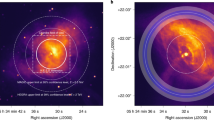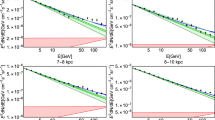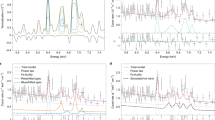Abstract
Cosmic rays (CR) are energetic nuclei that permeate the entire Galactic disk. Their existence requires the presence of powerful particle accelerators. While Galactic supernova explosions may supply the required energy, there is growing evidence that they cannot explain all of the observed properties of cosmic rays, such as their maximum particle energy and isotopic composition. Among Galactic objects, winds from stellar clusters meet the energetic requirement and provide a suitable environment for particle acceleration. The recent detection of some of these objects in γ rays confirms that they indeed harbour high-energy particles. However, as most supernovae explode inside stellar clusters, it is difficult to distinguish the contribution of winds to particle acceleration. Here we report the detection of young star clusters in the nearby Vela molecular ridge star-forming region. The young age of the systems guarantees an unbiased estimate of the stellar CR luminosity free from any supernova or pulsar contamination and allows us to draw conclusions on the acceleration efficiency and the total power supplied by these objects. We demonstrate that much more than 1% of the wind mechanical power is converted into CRs and consequently conclude that a small but non-negligible fraction, ~1–10% of the CR population, is contributed by stellar clusters.
This is a preview of subscription content, access via your institution
Access options
Access Nature and 54 other Nature Portfolio journals
Get Nature+, our best-value online-access subscription
$29.99 / 30 days
cancel any time
Subscribe to this journal
Receive 12 digital issues and online access to articles
$119.00 per year
only $9.92 per issue
Buy this article
- Purchase on Springer Link
- Instant access to full article PDF
Prices may be subject to local taxes which are calculated during checkout


Similar content being viewed by others
Data availability
The authors made use of publicly available data that can be retrieved at https://fermi.gsfc.nasa.gov/cgi-bin/ssc/LAT/LATDataQuery.cgi. Other data related to this work can be found on figshare: https://doi.org/10.6084/m9.figshare.24467155. Source data are provided with this paper.
Code availability
The authors made use of publicly available analysis software. In particular: fermipy v.1.0.2 available at https://github.com/fermiPy/fermipy/blob/master/docs/index.rst and naima available at https://github.com/zblz/naima.
References
Seo, J., Kang, H. & Ryu, D. The contribution of stellar winds to cosmic ray production. J. Korean Astron. Soc. 51, 37–48 (2018).
Strong, A. W. et al. Global cosmic-ray related luminosity and energy budget of the Milky Way. Astrophys. J. Lett. 722, L58–L63 (2010).
Cesarsky, C. J. & Montmerle, T. Gamma rays from active regions in the galaxy: the possible contribution of stellar winds. Space Sci. Rev. 36, 173–193 (1983).
Casse, M. & Paul, J. A. On the stellar origin of the Ne-22 excess in cosmic rays. Astrophys. J. 258, 860–863 (1982).
Binns, W. R. et al. Cosmic-Ray Neon, Wolf-Rayet Stars, and the superbubble origin of Galactic Cosmic Rays. Astrophys. J. 634, 351–364 (2005).
Boschini, M. J. et al. Inference of the local interstellar spectra of cosmic-ray nuclei Z ≤ 28 with the GALPROP-HELMOD Framework. Astrophys. J., Suppl. Ser. 250, 27 (2020).
Aharonian, F., Yang, R. & de Oña Wilhelmi, E. Massive stars as major factories of Galactic cosmic rays. Nat. Astron. 3, 561–567 (2019).
Abeysekara, A. U. et al. HAWC observations of the acceleration of very-high-energy cosmic rays in the Cygnus Cocoon. Nat. Astron. 5, 465–471 (2021).
Cao, Z. et al. Ultrahigh-energy photons up to 1.4 petaelectronvolts from 12 γ-ray Galactic sources. Nature 594, 33–36 (2021).
Higdon, J. C., Lingenfelter, R. E., Higdon, J. C. & Lingenfelter, R. E. OB associations, supernova-generated superbubbles, and the source of cosmic rays. Astrophys. J. 628, 738–749 (2005).
Bykov, A. Nonthermal particles and photons in starburst regions and superbubbles. Astron. Astrophys. Rev. 22, 77 (2015).
Morlino, G., Blasi, P., Peretti, E. & Cristofari, P. Particle acceleration in winds of star clusters. Mon. Notices Royal Astron. Soc. 504, 6096–6105 (2021).
Vieu, T., Gabici, S., Tatischeff, V. & Ravikularaman, S. Cosmic ray production in superbubbles. Mon. Notices Royal Astron. Soc. 512, 1275–1293 (2022).
Aharonian, F. et al. A deep spectromorphological study of the γ -ray emission surrounding the young massive stellar cluster Westerlund 1. Astron. Astrophys. 666, A124 (2022).
Wright, N. J., Drew, J. E. & Mohr-Smith, M. The massive star population of Cygnus OB2. Mon. Notices Royal Astron. Soc. 449, 741–760 (2015).
Mestre, E. et al. Probing the hadronic nature of the gamma-ray emission associated with Westerlund 2. Mon. Notices Royal Astron. Soc. 505, 2731–2740 (2021).
Maurin, G., Marcowith, A., Komin, N., Krayzel, F. & Lamanna, G. Embedded star clusters as sources of high-energy cosmic rays modelling and constraints. Astron. Astrophys. 591, A71 (2016).
Ekström, S. et al. Grids of stellar models with rotation. I. Models from 0.8 to 120 M⊙ at solar metallicity (Z = 0.014). Astron. Astrophys. 537, A146 (2012).
Wood, D. O. S., Churchwell, E. & Observatory, W. Massive stars embedded in molecular clouds: their population and distribution in the galaxy. Astrophys. J. 340, 265–272 (1989).
Mascoop, J. L. et al. The Galactic H ii region luminosity function at radio and infrared wavelengths. Astrophys. J. 910, 159 (2021).
Anderson, L. D. et al. The WISE catalog of Galactic HII regions. Astrophys. J. 212, 1 (2014).
Rodgers, A. W., Campbell, C. T. & Whiteoak, J. B. A catalogue of H α-emission regions in the Southern Milky Way. Mon. Notices Royal Astron. Soc. 121, 103–110 (1960).
Abdollahi, S. et al. Incremental Fermi Large Area Telescope Fourth Source Catalog. Astrophys. J. 260, 53 (2022).
Manchester, R. N., Hobbs, G. B., Teoh, A. & Hobbs, M. The Australia Telescope National Facility Pulsar Catalogue. Astron. J. 129, 1993–2006 (2005).
Malyshev, D. V. & Bhat, A. Multi-class classification of Fermi-LAT sources with hierarchical class definition. Mon. Notices Royal Astron. Soc. 521, 6195–6209 (2023).
Wolk, S. J., Bourke, T. L. & Vigil, M. Handbook of Star Forming Regions Vol. II (Astronomical Society of the Pacific, 2008).
Wolk, S. J., Bourke, T. L., Smith, R. K., Spitzbart, B. & Alves, J. O. Discovery of nonthermal X-ray emission from the embedded massive star-forming region RCW 38. Astrophys. J. 580, 161–165 (2002).
Zucker, C. et al. A compendium of distances to molecular clouds in the Star Formation Handbook. Astron. Astrophys. 633, A51 (2020).
Ellerbroek, L. E. et al. Rcw36: Characterizing the outcome of massive star formation. Astron. Astrophys. 558, A102 (2013).
Prisinzano, L. et al. Astrophysics low-mass star formation and subclustering in the H II regions RCW 32, 33, and 27 of the Vela Molecular Ridge. A photometric diagnostics for identifying M-type stars. Astron. Astrophys. 617, 63 (2018).
Massi, F., Lorenzetti, D. & Giannini, T. Star formation in the Vela molecular clouds. V. Young stellar objects and star clusters towards the C-cloud. Astron. Astrophys. 399, 147 (2003).
Bik, A. et al. Sequential star formation in RCW 34: a spectroscopic census of the stellar content of high-mass star-forming regions. Astrophys. J. 713, 883–899 (2010).
Weaver, R. et al. Interstellar bubbles. II. Structure and evolution. Astrophys. J. 218, 377–395 (1977).
Lallement, R., Vergely, J. L., Babusiaux, C. & Cox, N. L. Updated Gaia -2MASS 3D maps of Galactic interstellar dust. Astron. Astrophys. 661, A147 (2022).
Yadav, N., Mukherjee, D., Sharma, P. & Nath, B. B. How multiple supernovae overlap to form superbubbles. Mon. Notices Royal Astron. Soc. 465, 1720–1740 (2017).
Cantò, J., Raga, A. C. & Rodriguez, L. F. The hot, diffuse gas in a dense cluster of massive stars. Astrophys. J. 536, 896–901 (2000).
Bourke, T. L., Myers, P. C., Robinson, G. & Hyland, A. R. New OH Zeeman measurements of magnetic field strengths in molecular clouds. Astrophys. J. 554, 916–932 (2001).
Badmaev, D. V., Bykov, A. M. & Kalyashova, M. E. Inside the core of a young massive star cluster: 3D MHD simulations. Mon. Notices Royal Astron. Soc. 517, 2818–2830 (2022).
Padovani, M., Marcowith, A., Sánchez-Monge, Á., Meng, F. & Schilke, P. Non-thermal emission from cosmic rays accelerated in H II regions. Astron. Astrophys. 630, A72 (2019).
Zabalza, V. Naima: A Python package for inference of relativistic particle energy distributions from observed nonthermal spectra. In Proc. 34th International Cosmic Ray Conference (Proceedings of Science, 2015).
Aharonian, F. A. Very High Energy Cosmic Gamma Radiation: A Crucial Window on the Extreme Universe (World Scientific Publishing, 2004).
Tatischeff, V., Raymond, J. C., Duprat, J., Gabici, S. & Recchia, S. The origin of Galactic cosmic rays as revealed by their composition. Mon. Notices Royal Astron. Soc. 508, 1321–1345 (2021).
Ackermann, M. et al. Search for extended sources in the galactic plane using six years of Fermi-Large Area Telescope pass 8 data above 10 GeV. Astrophys. J. 843, 139 (2017).
Mattox, J. R. et al. The likelihood analysis of EGRET data. Astrophys. J. 461, 396 (1996).
The Fermi-LAT collaboration. Fermi Large Area Telescope Fourth Source Catalog. Astrophys. J. 242, 33 (2019).
Vladimirov, A. E. et al. GALPROP WebRun: an internet-based service for calculating galactic cosmic ray propagation and associated photon emissions. Computer Phys. Commun. 182, 1156–1161 (2011).
Yusifov, I. & Kucuk, I. Revisiting the radial distribution of pulsars in the Galaxy. Astron. Astrophys. 422, 545–553 (2004).
Dame, T. M., Hartmann, D. & Thaddeus, P. The Milky Way in molecular clouds: a new complete CO survey. Astrophys. J. 547, 792–813 (2000).
Ben Bekhti, N. et al. HI4PI: a full-sky Hi survey based on EBHIS and GASS. Astron. Astrophys. 594, A116 (2016).
Ade, P., Aghanim, N., Arnaud, M. & Ashdown, M. Planck early results. XIX. All-sky temperature and dust optical depth from Planck and IRAS. Constraints on the ‘dark gas’ in our Galaxy. Astron. Astrophys. 536, 16 (2011).
Ballet, J., Bruel, P., Burnett, T. H., Lott, B. & The Fermi-LAT collaboration. Fermi Large Area Telescope Fourth Source Catalog Data Release 4 (4FGL-DR4). Preprint at https://doi.org/10.48550/arXiv.2307.12546 (2023).
Bolatto, A. D., Wolfire, M. & Leroy, A. K. The CO-to-H 2 conversion factor. Annu. Rev. Astron. Astrophys. 51, 207–268 (2013).
Acero, F. et al. Development of the model of Galactic interstellar emission for standard point-source analysis of Fermi Large Area Telescope data. Astrophys. J. 223, 26 (2016).
Park, J., Caprioli, D. & Spitkovsky, A. Simultaneous acceleration of protons and electrons at nonrelativistic quasiparallel collisionless shocks. Phys. Rev. Lett. 114, 085003 (2015).
Kafexhiu, E., Aharonian, F., Taylor, A. M. & Vila, G. S. Parametrization of gamma-ray production cross-sections for pp interactions in a broad proton energy range from the kinematic threshold to PeV energies. Phys. Rev. D. 90, 123014 (2014).
Massi, F. et al. Dense cores and star formation in the giant molecular cloud Vela C. Astron. Astrophys. 628, A110 (2019).
Acknowledgements
We would like to acknowledge J. Hinton, E. Amato, G. Morlino, R. Tuffs and M. Lemoine-Goumard for the suggestions and discussion. G.P. and S.G. are supported by Agence Nationale de la Recherche (grant ANR-21-CE31-0028). S.C. acknowledges support from the Polish Science Centre grant DEC-2017/27/B/ST9/02272.
Author information
Authors and Affiliations
Contributions
G.P. led the data analysis, proposed the interpretation and produced the manuscript and its figures. S.C. proposed the target region as a case study. V.B. cross-checked the Fermi-LAT analysis. G.P., S.G., S.C. and F.A. gave significant inputs on data interpretation. All authors participated in the discussions and editing of the paper.
Corresponding author
Ethics declarations
Competing interests
The authors declare no competing interests.
Peer review
Peer review information
Nature Astronomy thanks the anonymous reviewers for their contribution to the peer review of this work.
Additional information
Publisher’s note Springer Nature remains neutral with regard to jurisdictional claims in published maps and institutional affiliations.
Supplementary information
Supplementary Information
Supplementary Figs. 1–3.
Source data
Source Data Fig. 1
Spectral points. This data file contains the spectral energy distributions of the clusters discussed in the paper.
Rights and permissions
Springer Nature or its licensor (e.g. a society or other partner) holds exclusive rights to this article under a publishing agreement with the author(s) or other rightsholder(s); author self-archiving of the accepted manuscript version of this article is solely governed by the terms of such publishing agreement and applicable law.
About this article
Cite this article
Peron, G., Casanova, S., Gabici, S. et al. The contribution of winds from star clusters to the Galactic cosmic-ray population. Nat Astron 8, 530–537 (2024). https://doi.org/10.1038/s41550-023-02168-6
Received:
Accepted:
Published:
Issue Date:
DOI: https://doi.org/10.1038/s41550-023-02168-6
This article is cited by
-
The hunt for PeVatrons as the origin of the most energetic photons observed in the Galaxy
Nature Astronomy (2024)



